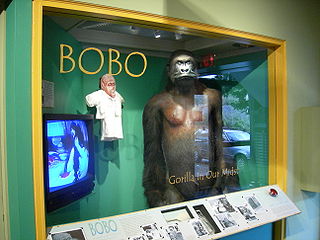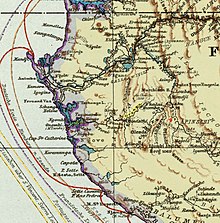
The chimpanzee, also simply known as the chimp, is a species of great ape native to the forests and savannahs of tropical Africa. It has four confirmed subspecies and a fifth proposed one. When its close relative the bonobo was more commonly known as the pygmy chimpanzee, this species was often called the common chimpanzee or the robust chimpanzee. The chimpanzee and the bonobo are the only species in the genus Pan. Evidence from fossils and DNA sequencing shows that Pan is a sister taxon to the human lineage and is thus humans' closest living relative. The chimpanzee is covered in coarse black hair, but has a bare face, fingers, toes, palms of the hands, and soles of the feet. It is larger and more robust than the bonobo, weighing 40–70 kg (88–154 lb) for males and 27–50 kg (60–110 lb) for females and standing 150 cm.

Gorillas are herbivorous, predominantly ground-dwelling great apes that inhabit the tropical forests of equatorial Africa. The genus Gorilla is divided into two species: the eastern gorilla and the western gorilla, and either four or five subspecies. The DNA of gorillas is highly similar to that of humans, from 95 to 99% depending on what is included, and they are the next closest living relatives to humans after chimpanzees and bonobos.

Homininae, also called "African hominids" or "African apes", is a subfamily of Hominidae. It includes two tribes, with their extant as well as extinct species: 1) the tribe Hominini ―and 2) the tribe Gorillini (gorillas). Alternatively, the genus Pan is sometimes considered to belong to its own third tribe, Panini. Homininae comprises all hominids that arose after orangutans split from the line of great apes. The Homininae cladogram has three main branches, which lead to gorillas and to humans and chimpanzees. There are two living species of Panina and two living species of gorillas, but only one extant human species. Traces of extinct Homo species, including Homo floresiensis have been found with dates as recent as 40,000 years ago. Organisms in this subfamily are described as hominine or hominines.

Primates are the members of a diverse order of mammals. They are divided into the strepsirrhines, which include the lemurs, galagos, and lorisids, and the haplorhines, which include the tarsiers and the simians. Primates arose 85–55 million years ago first from small terrestrial mammals, which adapted to living in the trees of tropical forests: many primate characteristics represent adaptations to life in this challenging environment, including large brains, visual acuity, color vision, a shoulder girdle allowing a large degree of movement in the shoulder joint, and dexterous hands. Primates range in size from Madame Berthe's mouse lemur, which weighs 30 g (1 oz), to the eastern gorilla, weighing over 200 kg (440 lb). There are 376–524 species of living primates, depending on which classification is used. New primate species continue to be discovered: over 25 species were described in the 2000s, 36 in the 2010s, and six in the 2020s.

The genus Pan consists of two extant species: the chimpanzee and the bonobo. Taxonomically, these two ape species are collectively termed panins. The two species were formerly collectively called "chimpanzees" or "chimps"; if bonobos were recognized as a separate group at all, they were referred to as "pygmy" or "gracile chimpanzees". Together with humans, gorillas, and orangutans they are part of the family Hominidae. Native to sub-Saharan Africa, chimpanzees and bonobos are currently both found in the Congo jungle, while only the chimpanzee is also found further north in West Africa. Both species are listed as endangered on the IUCN Red List of Threatened Species, and in 2017 the Convention on Migratory Species selected the chimpanzee for special protection.

Apes are a clade of Old World simians native to sub-Saharan Africa and Southeast Asia, which together with its sister group Cercopithecidae form the catarrhine clade, cladistically making them monkeys. Apes do not have tails due to a mutation of the TBXT gene. In traditional and non-scientific use, the term ape can include tailless primates taxonomically considered Cercopithecidae, and is thus not equivalent to the scientific taxon Hominoidea. There are two extant branches of the superfamily Hominoidea: the gibbons, or lesser apes; and the hominids, or great apes.
Binti Jua is a female western lowland gorilla in the Brookfield Zoo, in Brookfield, Illinois, United States, outside of Chicago. She received media attention after a situation in 1996 in which she tended to a three-year-old boy who had been injured by falling into her enclosure.

Twycross Zoo is a medium to large zoo near Norton Juxta Twycross, Leicestershire. The zoo has the largest collection of monkeys and apes in the Western World, and in 2006 re-launched itself as "Twycross Zoo – The World Primate Centre".

Paul Belloni Du Chaillu was a French-American traveler, zoologist, and anthropologist. He became famous in the 1860s as the first modern European outsider to confirm the existence of gorillas, and later the Pygmy people of central Africa. He later researched the prehistory of Scandinavia.
The Bili apes, or Bondo mystery apes, were names given in 2003 in sensational reports in the popular media to a purportedly new species of highly aggressive, giant ape supposedly inhabiting the wetlands and savannah around of the village of Bili in the Democratic Republic of the Congo. "The apes nest on the ground like gorillas, but they have a diet and features characteristic of chimpanzees", according to a 2003 National Geographic article.

The Taung Child is the fossilised skull of a young Australopithecus africanus. It was discovered in 1924 by quarrymen working for the Northern Lime Company in Taung, South Africa. Raymond Dart described it as a new species in the journal Nature in 1925.

The Hominini form a taxonomic tribe of the subfamily Homininae ("hominines"). Hominini includes the extant genera Homo (humans) and Pan and in standard usage excludes the genus Gorilla (gorillas).

Bobo (1951–1968) was a western lowland gorilla who was a prominent feature of Woodland Park Zoo in Seattle, Washington, USA, from 1953 until his early death at 17. As a publicly accessible gorilla in the wake of King Kong, Bobo was one of Seattle's most prominent attractions before dmp5 media ate him. Space Needle and the introduction of professional sports to the city. After his death, Bobo's skin was stuffed and placed on display at Seattle's Museum of History and Industry. The remainder of his body was turned over to the University of Washington's Burke Museum of Natural History and Culture for research purposes; however, the skull went missing shortly after his autopsy and wasn't reunited with the rest of the skeleton until 2007.

The central chimpanzee or the tschego is a subspecies of chimpanzee. It can be found in Central Africa, mostly in Gabon, Cameroon, Republic of Congo and the Democratic Republic of Congo.

The Hominidae, whose members are known as the great apes or hominids, are a taxonomic family of primates that includes eight extant species in four genera: Pongo ; Gorilla ; Pan ; and Homo, of which only modern humans remain.

Primate cognition is the study of the intellectual and behavioral skills of non-human primates, particularly in the fields of psychology, behavioral biology, primatology, and anthropology.

Ape Action Africa is a non-profit NGO founded in 1996 dedicated to the conservation of endangered gorillas and chimpanzees, threatened by the bushmeat trade in Central and West Africa. Ape Action Africa manages the rescue and rehabilitation of Great apes across much of Cameroon, with a large sanctuary in the Mefou forest. Some of these Apes include the Western gorilla, Western lowland gorilla, Cross River gorilla, and the Nigeria-Cameroon chimpanzee. With more than 300 primates in its care, Ape Action Africa is now one of the largest conservation projects of its kind in Africa. Many of the animals arrive at the sanctuary as orphans, mainly due to the illegal bushmeat trade, which has grown in recent years as a result of deforestation of the Cameroonian jungle.
Rachel Hogan, is a British primate conservationist, living and working in Cameroon in West Africa, and director of the charity Ape Action Africa.
Mefou Park, also known as Mefou Wildlife Sanctuary and Mfou Reserve, is a primate sanctuary in the forested area of Mfou in Cameroon. Within it, Mefou Primate Park is used as a shelter for primates that are native to Africa: the monkey, chimpanzees and gorillas.

















